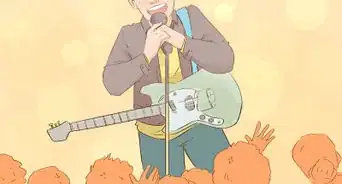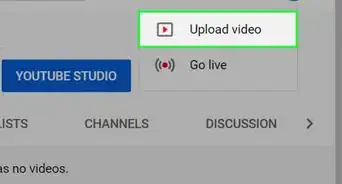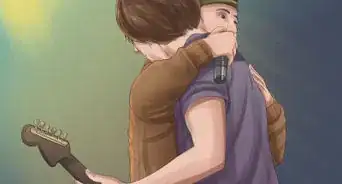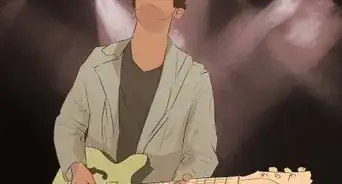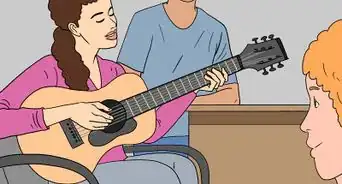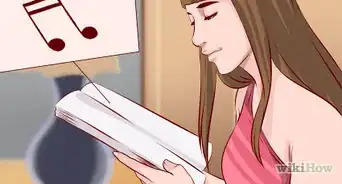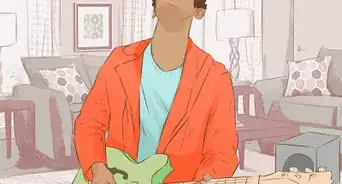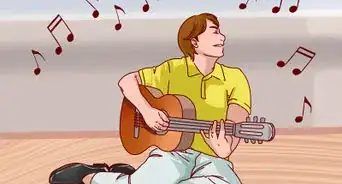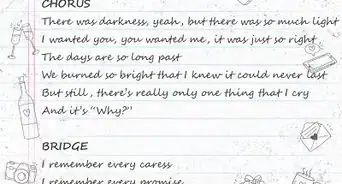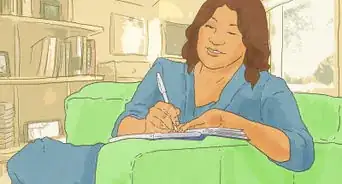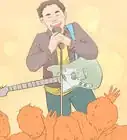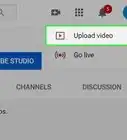This article was co-authored by Tanisha Hall and by wikiHow staff writer, Amber Crain. Tanisha Hall is a Vocal Coach and the Founder and Executive Director of White Hall Arts Academy, Inc. an organization based in Los Angeles, California that offers a multi-level curriculum focused on fundamental skills, technique, composition, theory, artistry, and performance at a conservatory level. Ms. Hall's current and previous students include Galimatias, Sanai Victoria, Ant Clemons, and Paloma Ford. She earned a BA in Music from the Berklee College of Music in 1998 and was a recipient of the Music Business Management Achievement Award.
There are 16 references cited in this article, which can be found at the bottom of the page.
wikiHow marks an article as reader-approved once it receives enough positive feedback. This article received 44 testimonials and 82% of readers who voted found it helpful, earning it our reader-approved status.
This article has been viewed 7,044,098 times.
Anyone can write a song! All you really need is some basic knowledge of a melody instrument like a guitar or a piano, an idea, and the proper methodology. As long as you know how to brainstorm ideas for your song, how to write lyrics, and how to put a song together, you can call yourself a songwriter. Before you know it, you might even be up on stage singing your song for a roaring crowd!
Steps
Writing the Music
-
1Decide what genre you want to work within for your song. Different musical genres have specific classic features that you may want to use in your song. If you’re writing a country song, you may want to use a steel guitar and build your melodies and lyrics around the theme of loss and hardship. If you’re writing a rock song, you might use power chords and write lyrics about rebellion.[1]
-
2Choose a rhythm and beat that matches your song’s mood and genre. Faster rhythms and beats work best for upbeat or chaotic songs, like techno and punk rock music. Sad or emotional songs, like pop and country songs, usually have slower rhythms and beats. If your song doesn’t fit into any of those categories, you can try a mid-tempo approach, which is typical for classic rock music.[2]
- For example, a punk rock song typically has a fast, driving rhythm and uses a 4/4 time signature (the beat is a quarter note lasting 1 second and there are 4 beats per measure).
- Reggae music often uses syncopated beats, which are beats played off the rhythm, to convey an unconventional vibe.[3]
- Try searching online to find out what rhythm and beats the particular genre of music you want to play uses.
Advertisement -
3Work out the basic melody on a piano or guitar. Even if you don’t intend to use these instruments in your song, they are easy to experiment with when it comes to developing a melody. Start by playing around with common keys, such as G, A, C, D, E, and F. Keep your song’s intended theme in mind and settle on a key that you feel can convey that.
-
4Develop the melody using major and minor scales. Use scales in the key you chose to convey the mood you’re trying to express. Experiment with different melodies until you hit on something that sounds and feels right for your song. Major keys are usually considered to be happy, upbeat, or energetic. Minor scales are usually considered to be melancholy or emotional.
- For example, D minor is often cited as being the saddest key.
- C major is one of the happiest sounding keys.
- Depending on your song’s theme, you can also alternate between major and minor keys to convey a variety of feelings.
-
5Take guitar lessons if you need help writing melodies. You don't have to master the guitar to write a song, but it really helps to know the basics, like how to create different notes, play chords, and experiment with tunings. You can look for a local guitar teacher at a nearby music shop, or check Craigslist for possibilities.
- You can also consider using video tutorials online to sharpen your skills.
- Once you've got the basics down, start experimenting with melodies for your song and use your guitar to help you develop ideas.
-
6Enlist the help of a co-writer if you need help writing the music. If you are envisioning elements for your song that you know you can't create yourself, consider asking a musically talented friend to join you in the writing process. You can explain the theme, tone, and lyrics you have in mind for the song, and then work with your friend to translate those ideas into music.
- If you don't know someone who can assist you with this, consider putting an ad up on Craigslist or posting on message boards to find someone to collaborate with online.
-
7Experiment with music software to create music. If you can't play an instrument, don't let that stop you from writing songs! Many people use music software like Ableton to create their music, especially electronic music artists. The software comes with thousands of pre-recorded sounds for drums, bass, chords, and melodies, allowing you to manipulate and combine them in endless ways to make your own songs.[4]
- You can explore synth sounds, guitar effects, filters, and so much more with this software.
- You can also buy separate plug-ins to add entire libraries of new sounds to your software's stock sounds. The possibilities really are limitless.
EXPERT TIPHalle Payne has been writing songs since the age of eight. She has written hundreds of songs for guitar and piano, some of which are recorded and available on her Soundcloud or Youtube channel. Most recently, Halle was a part of a 15-person collaboration in Stockholm, Sweden, called the Skål Sisters.Singer/Songwriter
 Halle Payne
Halle Payne
Singer/SongwriterHalle Payne, Singer/Songwriter, tells us: "If you're new to recording, GarageBand is a really great option. If you want to mix and master your tracks like a professional sound engineer, you can graduate to a paid software like Logic or Pro-Tools, the softwares used in most studios."
Adding Lyrics
-
1Choose a title for your song. It might sound counter-intuitive, but one of the easiest ways to come up with song ideas is to think of potential titles. Listen and look for particularly catchy or pithy phrases in TV shows, movies, books, and everyday conversation and write them down in a notebook or in your phone. You can also wait to title the song until after you've written the melody and lyrics. One approach isn't better than the other when it comes to titles, so do what feels the most natural for you.[5]
- It might help to make a list of questions suggested by your title. Then, your lyrics can answer all of those questions by the end of the song.[6]
- For example, the title “Heartbreak Hotel” asks the questions, “What is a Heartbreak Hotel?” “What happens there?” and “Where is it?” Elvis answers all of these questions in his lyrics.[7]
-
2Come up with a hook for your song. The hook in a song is the catchy phrase that worms its way into your brain and never leaves, and is frequently used as the title of the song. Play around with ideas and melodies until you hit on something that feels right. If you have a working list of title ideas already, experiment to see if any work particularly well as a hook by singing them to various melodies.[8]
- The hook of Lady Gaga’s song “Bad Romance” is “Rah rah ah-ah-ah!/Ro mah ro-mah-mah/Gaga oh-la-la!/Want your bad romance.”[9]
- The hook of Carly Rae Jepsen’s song “Call Me Maybe” is “Hey, I just met you and this is crazy/But here's my number, so call me maybe.”[10]
- The hook of Neil Diamond’s song “Sweet Caroline” is “Sweet Caroline.”[11]
EXPERT TIPHalle Payne has been writing songs since the age of eight. She has written hundreds of songs for guitar and piano, some of which are recorded and available on her Soundcloud or Youtube channel. Most recently, Halle was a part of a 15-person collaboration in Stockholm, Sweden, called the Skål Sisters.Singer/Songwriter
 Halle Payne
Halle Payne
Singer/SongwriterHalle Payne, singer/songwriter, tells us: "A hook is that quality of a song that makes you want to sing it over and over again. Most hooks in songs are vocal melodies, but a hook can be anything — from a funky bass line to a call and response. In "Are you gonna be my girl?" by Jet, for example, one big hook in the song is the guitar riff right after the title line.
-
3Build a chorus around your hook. Sometimes, your hook can serve as your entire chorus. Other times, it’s just a part of your chorus, usually at the beginning or end. Regardless, your chorus should generally be vaguer than your verses. Use your chorus as a way of summarizing the themes of your song without getting into specifics.[12]
- For example, the chorus of “You’re So Vain” by Carly Simon introduces the vanity of her subject as the theme of the song, but doesn’t specifically explain why the subject is vain.[13]
-
4Write a verse that builds on the themes introduced by your chorus. Your verses should use strong, concrete imagery and specific examples to build on the more vague themes introduced by your chorus.[14]
- For example, in the first verse of “You’re So Vain,” Carly Simon sings “You had one eye in the mirror/As you watched yourself gavotte” to establish her subject’s vanity with a specific example.[15]
-
5Write 2 more verses that follow the same pattern as your first. Once you’ve written the first verse, the next 2 should be fairly easy to write in a short period of time. The other 2 verses should follow the same lyrical and melodic patterns as your first while providing new information.[16]
Finalizing Your Song
-
1Decide whether or not you want to add a bridge to your song. A bridge is like another chorus that is only sung once and presents the themes of your song in a new way. Use your bridge to spice up your song by singing new lyrics and in a new key or with different chords in the same key.[17]
- Make sure the lyrics of your bridge are vague like the lyrics of your chorus. Don’t introduce new specifics.
- You could also consider using your bridge as an opportunity for an instrumental solo if you want to feature your skill with a particular instrument.
-
2Nail down the final structure of your song. The most common song structure used today is Verse/ Chorus/ Verse/ Chorus/ Bridge/ Chorus. But, you can feel free to play around with this structure based on what works best for your song. Take the elements you’ve already created and experiment by moving them around, repeating some of them, and so on until the structure feels right.[18]
- Some genres use specific song structures. For example, EDM most often uses Intro/ Verse/ Chorus/ Breakdown/ Verse/ Chorus/ Verse/ Chorus/ Bridge/ Chorus/ Outro.[19]
-
3Add other instruments to create a fuller sound. Once you’ve finished writing your song, you can add in instruments like the drums, bass guitar, and keyboard to drive and accent the melody. Your other instruments should be played in the same key and time signature you settled on previously.
- If you don’t know how to play other instruments, try recording the foundation of the song using your computer, then use music software like Ableton or GarageBand to add new elements to the song.
- You can even go on YouTube and find instrumentals.
- When you find an instrumental you like, reach out to the person who made it. See what you need to do to use it. Sometimes it's free.[20]
-
4Practice your song until you have it memorized. Start off by practicing the parts of your song individually until you have them each memorized. Then, move on to practicing all of them together in the correct order until you can transition smoothly from one element to the next without even thinking about it.[21]
-
5Record your song. Once you have your song memorized, you should record it. Use your phone, a digital recorder, a laptop and software, or a video camera. Once you have your recording, make sure to make a copy of it or upload it to the cloud. That way you’ll never forget your song or lose it.
- You can hold your iPhone or Android phone sideways and make a music video.[22]
Song-Writing Help
Community Q&A
-
QuestionWhat if you have a song that sounds good, but no one understands it?
 Community AnswerPublish it, or share it on the internet. With such a wide audience possible, there is bound to be at least one person on the internet who understands. If there is no-one, enjoy it yourself, you do not need fans to be a good song writer. But have faith, people will understand the song in their own way, when you get it out there to a sufficient amount of listeners.
Community AnswerPublish it, or share it on the internet. With such a wide audience possible, there is bound to be at least one person on the internet who understands. If there is no-one, enjoy it yourself, you do not need fans to be a good song writer. But have faith, people will understand the song in their own way, when you get it out there to a sufficient amount of listeners. -
QuestionHow do you get inspiration?
 Community AnswerImprovise on your instrument for a while. Listen to other songs, look at visual art, take a walk in nature. Every creative person finds inspiration in a different place. Remember that it's very rare for a song to jump into your head fully formed. Put in the hours to take that initial idea and shape it into something great.
Community AnswerImprovise on your instrument for a while. Listen to other songs, look at visual art, take a walk in nature. Every creative person finds inspiration in a different place. Remember that it's very rare for a song to jump into your head fully formed. Put in the hours to take that initial idea and shape it into something great. -
QuestionHow do you write a tune to match your lyrics?
 Community AnswerTry listening to songs with the same emotional tone as your lyrics. Play around with the scales, rhythm, or instrumentation that grabs you in those songs to get ideas for your own.
Community AnswerTry listening to songs with the same emotional tone as your lyrics. Play around with the scales, rhythm, or instrumentation that grabs you in those songs to get ideas for your own.
References
- ↑ https://mysongcoach.com/write-your-songs-in-a-genre/
- ↑ https://www.dummies.com/art-center/music/guitar/recognizing-different-rock-guitar-rhythm-styles/
- ↑ https://www.dummies.com/art-center/music/guitar/recognizing-different-rock-guitar-rhythm-styles/
- ↑ https://learningmusic.ableton.com/
- ↑ https://mysongcoach.com/write-a-song-in-ten-steps/
- ↑ https://www.musicindustryhowto.com/how-to-write-a-song-for-beginners-a-step-by-step-guide-to-becoming-a-songwriter/
- ↑ https://www.musicindustryhowto.com/how-to-write-a-song-for-beginners-a-step-by-step-guide-to-becoming-a-songwriter/
- ↑ https://www.bmi.com/news/entry/how-to-write-song-hooks-that-hook-you-in
- ↑ https://www.billboard.com/articles/columns/pop-shop/6731053/greatest-catchiest-pop-hooks-ever
- ↑ https://www.billboard.com/articles/columns/pop-shop/6731053/greatest-catchiest-pop-hooks-ever
- ↑ https://www.billboard.com/articles/columns/pop-shop/6731053/greatest-catchiest-pop-hooks-ever
- ↑ https://www.bmi.com/news/entry/4_dos_and_donts_when_writing_songs
- ↑ https://genius.com/Carly-simon-youre-so-vain-lyrics
- ↑ https://www.musicindustryhowto.com/how-to-write-a-verse-for-a-song/
- ↑ https://genius.com/Carly-simon-youre-so-vain-lyrics
- ↑ https://www.musicindustryhowto.com/how-to-write-a-verse-for-a-song/
- ↑ https://www.bmi.com/news/entry/to_bridge_or_not_to_bridge_and_other_songwriting_questions1
- ↑ https://www.musicindustryhowto.com/how-to-write-a-song-for-beginners-a-step-by-step-guide-to-becoming-a-songwriter//
- ↑ https://blog.landr.com/write-song/
- ↑ https://www.soundstripe.com/blogs/how-can-i-legally-use-copyrighted-music-on-youtube
- ↑ http://www.askavocalcoach.com/articles/how-to-improve-singing-with-practice/
- ↑ https://www.pocket-lint.com/phones/news/131351-10-tips-for-recording-better-video-with-your-smartphone
About This Article
To write lyrics to a song, start by coming up with the hook, which is a catchy phrase you'll repeat throughout the chorus. Once you've got a hook, come up with a chorus that incorporates the hook and introduces the general theme behind your song. Next, write 2-3 verses that include specific examples and vivid imagery to help build on the theme you introduced in the chorus. Finally, organize your song according to the rhythm with verses in between repeated choruses. To learn how to come up with a bridge for your song, scroll down!
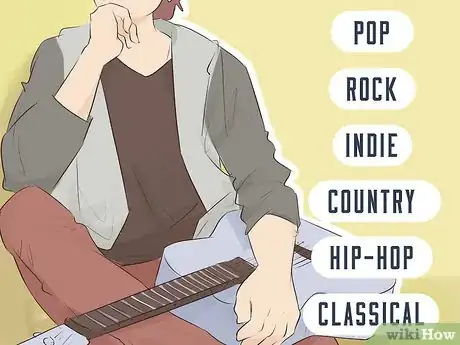
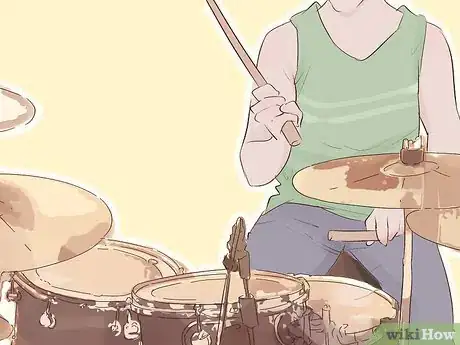



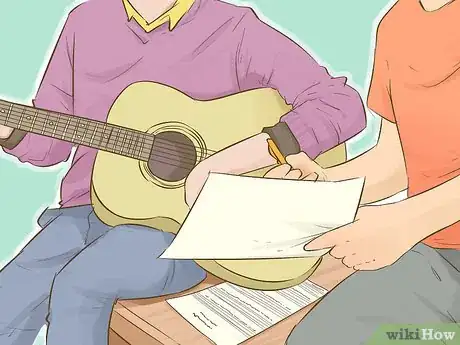
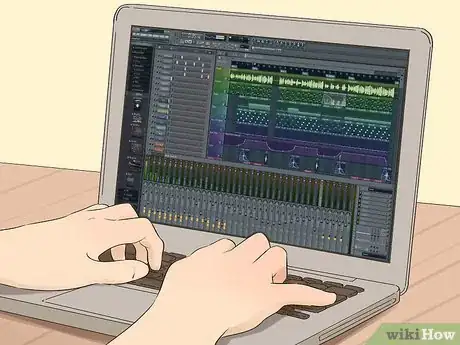

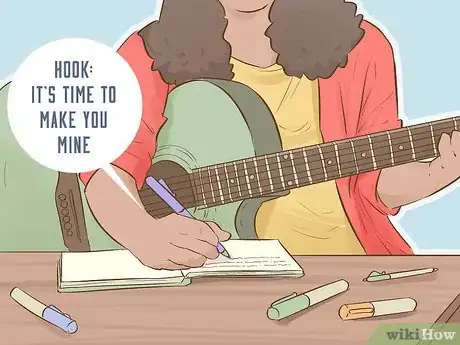
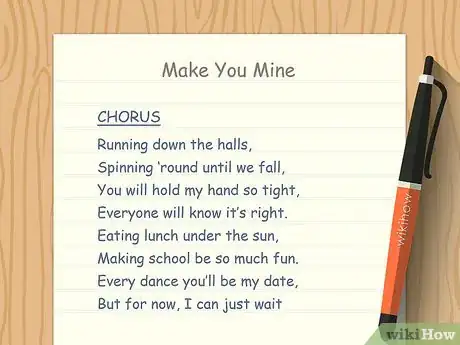
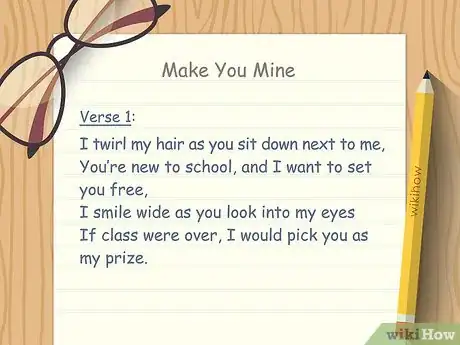

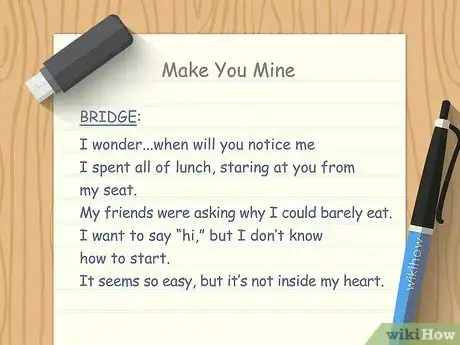

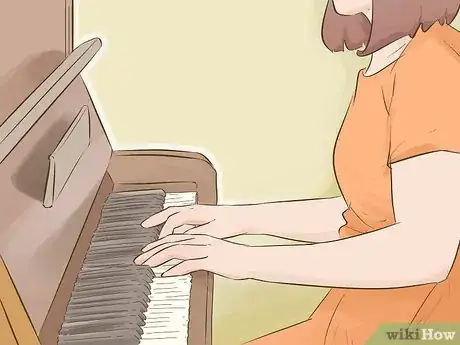
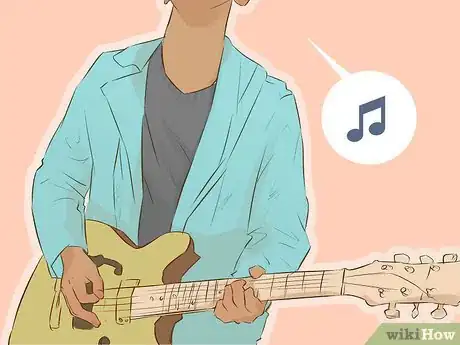
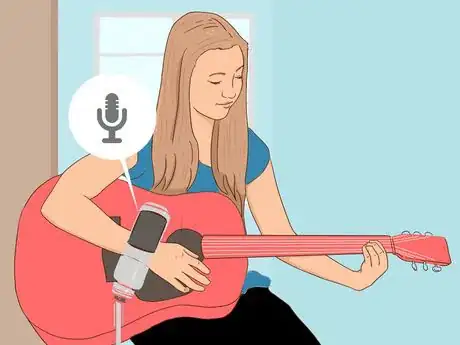
_sample.webp)
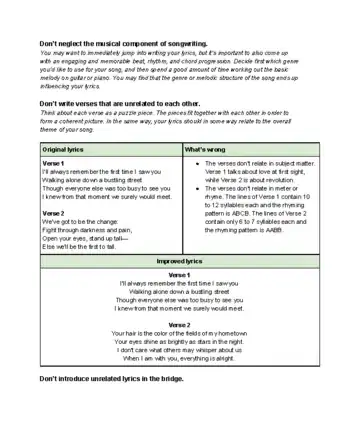
_sample.webp)
